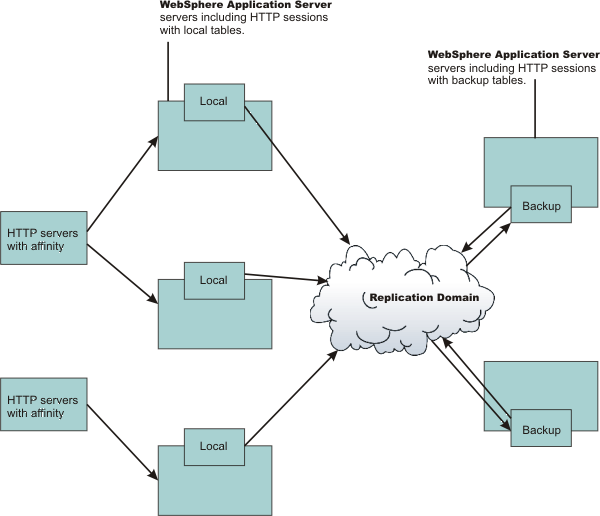Memory-to-memory topology: Client/server function
The client/server configuration, used to attain session affinity, consists of a cluster of servers that are configured as client only and server only. Using the client/server configuration has benefits such as isolating the handling of backup data from local data, recycling backup servers without affecting the servers running the application, and removing the need for a one-to-one correspondence between servers to attain session affinity.
The following figure depicts the client/server mode. There is a tier of applications servers that host Web applications using HTTP sessions, and these sessions are replicated out as they are created and updated. There is a second tier of servers without a Web application installed, where the session manager receives updates from the replication clients.

Benefits of the client/server configuration include:
- Isolation for failure recovery
- In this case we are isolating the handling of backup data from local data; aside from isolating the moving parts in case of a catastrophic failure in one of them, you again free up memory and processing in the servers processing the Web application.
- Isolation for stopping and starting
- You can recycle a backup server without affecting the servers running the application (when there are two or more backups, failure recovery is possible), and conversely recycle an application JVM without potentially losing that backup data for someone.
- Consolidation
- There is most likely no need to have a one-to-one correspondence between servers handling backups and those processing the applications; hence, you are again reducing the number of places to which you transfer the data.
- Disparate hardware:
- While you run your Web applications on cheaper hardware, you may have one or two more powerful computers in the back end of your enterprise that have the capacity to run a couple of session managers in replication server mode; allowing you to free up your cheaper Web application hardware to process the Web application.
Timing consideration: Start the backup appservers first to avoid unexpected timing windows. The clients attempt to replicate information and HTTP sessions to the backup servers as soon as they come up. As a result,
HTTP sessions that are created prior to the time at which the servers come up might not replicate successfully.
Related concepts
Memory-to-memory replication
Memory-to-memory topology: Peer-to-peer function
Memory-to-memory session partitioning
Related tasks
Configure memory-to-memory replication for the peer-to-peer mode (default memory-to-memory replication)
Configure memory-to-memory replication for the client/server mode   Â